Description 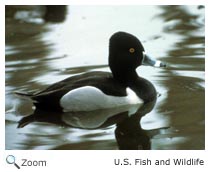 The ring-necked duck is a diving duck 15-18 inches in length with a wingspan of 24-26 inches. It has a bump on the crown of its head, a slate gray bill with a white ring around the tip, and yellow eyes. The ring-necked duck is a diving duck 15-18 inches in length with a wingspan of 24-26 inches. It has a bump on the crown of its head, a slate gray bill with a white ring around the tip, and yellow eyes.
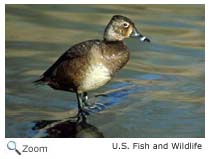 It gets its name from the
hard-to-see chestnut
ring around its neck. The male has a glossy purple head that looks black. He has a black chest, back, and rump; gray sides; and white stripes on the sides of his breast. He has a white stripe on his wings. The female has tan sides, a brown back, a white belly, and a white ring around her eyes. It gets its name from the
hard-to-see chestnut
ring around its neck. The male has a glossy purple head that looks black. He has a black chest, back, and rump; gray sides; and white stripes on the sides of his breast. He has a white stripe on his wings. The female has tan sides, a brown back, a white belly, and a white ring around her eyes.
Range 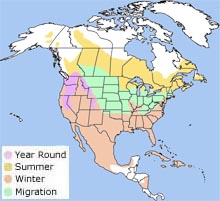 The ring-necked duck breeds across Canada south through the northern U.S. and into northern California and Colorado. It winters along the Pacific and Atlantic Coasts and and the southern U.S. south into Mexico, Central America, and the Caribbean. The ring-necked duck breeds across Canada south through the northern U.S. and into northern California and Colorado. It winters along the Pacific and Atlantic Coasts and and the southern U.S. south into Mexico, Central America, and the Caribbean.
|
|
Habitat
The ring-necked duck is found in shallow wetlands with emergent, submerged, or floating vegetation.
Diet 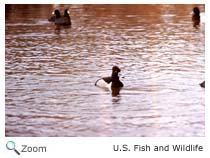 The ring-necked duck
dives in shallow water for aquatic vegetation like
wild celery, bulrush, pondweed, and pond lily. It may also dabble on and just below the surface for food. It also eats
mollusks, snails, aquatic insects, and small fish. The ring-necked duck
dives in shallow water for aquatic vegetation like
wild celery, bulrush, pondweed, and pond lily. It may also dabble on and just below the surface for food. It also eats
mollusks, snails, aquatic insects, and small fish.
Life Cycle 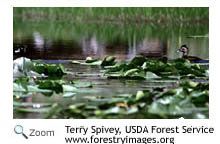 Ring-necked duck pairs form in the early spring. The female chooses a nesting site over or near the water in tall vegetation and builds a bowl-shaped nest on a platform of vegetation and lines it with down. She lays 8-12 eggs. The male leaves when the female begins incubating the eggs. The female
incubates the eggs for 28- 29 days.
The chicks fledge when they are about 50 days old. Ring-necked duck pairs form in the early spring. The female chooses a nesting site over or near the water in tall vegetation and builds a bowl-shaped nest on a platform of vegetation and lines it with down. She lays 8-12 eggs. The male leaves when the female begins incubating the eggs. The female
incubates the eggs for 28- 29 days.
The chicks fledge when they are about 50 days old.
Behavior
Unlike most other diving ducks, the ring-necked duck can take off from the water without running across its surface.
|

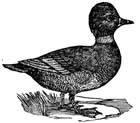


 The ring-necked duck breeds across Canada south through the northern U.S. and into northern California and Colorado. It winters along the Pacific and Atlantic Coasts and and the southern U.S. south into Mexico, Central America, and the Caribbean.
The ring-necked duck breeds across Canada south through the northern U.S. and into northern California and Colorado. It winters along the Pacific and Atlantic Coasts and and the southern U.S. south into Mexico, Central America, and the Caribbean.
